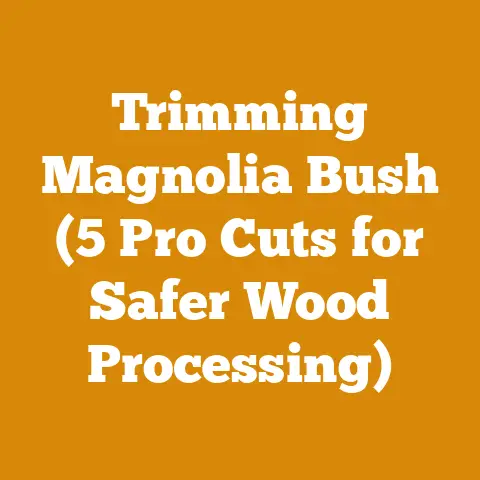How to Remove Poison Ivy from a Tree (5 Expert Arborist Hacks)
A majestic tree, standing tall and proud, is a sight to behold. Its presence enhances any landscape, providing shade, shelter, and a touch of natural beauty. But what happens when that beauty is marred by the unwelcome encroachment of poison ivy? This insidious vine, with its characteristic three-leaf clusters, can quickly transform a picturesque scene into a source of irritation and potential health hazard.
I’ve seen it happen countless times. A homeowner, eager to enjoy their outdoor space, suddenly finds themselves battling a rash that seems to appear out of nowhere. A seasoned logger, accustomed to navigating the forest, unknowingly brushes against a hidden tendril and spends the next few weeks nursing an uncomfortable reminder of its presence.
Removing poison ivy from a tree is not merely about aesthetics; it’s about protecting your health, the health of those around you, and the long-term well-being of the tree itself. Neglecting this task can lead to the vine eventually overtaking the tree, weakening its structure, and even killing it.
Understanding the Enemy: Poison Ivy Identification and Biology
Before we dive into the removal techniques, it’s crucial to understand what we’re dealing with. Poison ivy (Toxicodendron radicans) is a perennial vine that thrives in a variety of environments, from forests and fields to urban areas. Its most distinctive feature is its three-leaf cluster, often described as “leaves of three, let it be.” However, the appearance of these leaves can vary depending on the season and the plant’s maturity.
- Leaf Shape: The leaves can be smooth, toothed, or lobed, and their color can range from bright green in the spring to reddish-orange in the fall.
- Urushiol Oil: The culprit behind the itchy rash is urushiol, an oily resin found in all parts of the plant – leaves, stems, and roots. Urushiol is highly allergenic, and even a tiny amount can cause a severe reaction in sensitive individuals. I once learned this the hard way when I absentmindedly used a poison ivy stem as a makeshift tie for some saplings. The resulting rash was a painful reminder of the importance of vigilance.
- Growth Habits: Poison ivy can grow as a ground cover, a shrub, or a climbing vine. When climbing, it uses aerial rootlets to attach itself to trees, fences, and other structures. These rootlets can penetrate the bark, making removal a challenging task.
- Seed Dispersal: Birds play a significant role in spreading poison ivy seeds. They eat the berries and then deposit the seeds in new locations through their droppings. This is why you might find poison ivy popping up in unexpected places, even in the middle of your lawn.
Technical Data:
- Urushiol Sensitivity: Studies show that approximately 85% of the population is allergic to urushiol.
- Urushiol Persistence: Urushiol can remain active on surfaces for up to five years, even after the plant is dead.
- Leaflet Size: Poison ivy leaflets typically range from 3 to 8 centimeters in length.
- Aerial Rootlet Penetration: Aerial rootlets can penetrate up to 2 millimeters into the bark of a tree.
Safety First: Protecting Yourself from Urushiol Exposure
Before you even think about approaching a poison ivy-infested tree, it’s essential to take precautions to protect yourself from urushiol exposure. This means wearing appropriate personal protective equipment (PPE) and following strict hygiene practices.
- Protective Clothing: I always recommend wearing long sleeves, long pants, gloves, and closed-toe shoes when working around poison ivy. I prefer disposable coveralls for maximum protection.
- Glove Selection: Choose gloves made of vinyl or nitrile, as urushiol can penetrate latex. I always double-glove for extra security.
- Eye Protection: Wear safety glasses or goggles to prevent urushiol from splashing into your eyes.
- Respiratory Protection: If you’re using power tools or burning poison ivy, wear a respirator to avoid inhaling urushiol particles.
- Hygiene: After working around poison ivy, immediately wash your hands and any exposed skin with soap and water. Use a specialized poison ivy cleanser, if available. Launder your clothes separately in hot water with detergent. Clean your tools with rubbing alcohol or a bleach solution.
Safety Codes and Standards:
- OSHA (Occupational Safety and Health Administration): While OSHA doesn’t have specific regulations for poison ivy, it does require employers to provide a safe working environment, which includes protecting employees from exposure to hazardous substances like urushiol.
- ANSI (American National Standards Institute): ANSI standards provide guidelines for PPE, including gloves, eye protection, and respirators.
Personalized Story:
I remember one summer, I was helping a friend clear some overgrown brush from his property. We were both wearing gloves and long sleeves, but I got complacent and started wiping sweat from my forehead with my gloved hand. A few days later, I developed a nasty rash on my face. It was a painful reminder that even a small amount of urushiol can cause a significant reaction. From that day on, I’ve been extra cautious about avoiding contact with my face when working around poison ivy.
Expert Arborist Hacks for Removing Poison Ivy
Now that we’ve covered the basics of poison ivy identification and safety precautions, let’s get to the heart of the matter: how to remove poison ivy from a tree. Here are five expert arborist hacks that I’ve found to be effective over the years:
1. The Cut-and-Treat Method: A Targeted Approach
This method is best suited for situations where the poison ivy is relatively isolated and hasn’t completely engulfed the tree. It involves cutting the vine at the base and applying a systemic herbicide to the cut stump.
- Tools Required:
- Hand pruners or loppers
- Systemic herbicide (e.g., glyphosate or triclopyr)
- Paintbrush or applicator
- Gloves
- Eye protection
- Step-by-Step Instructions:
- Identify the Vine: Carefully locate the base of the poison ivy vine growing on the tree.
- Cut the Vine: Using hand pruners or loppers, cut the vine as close to the ground as possible.
- Apply Herbicide: Immediately after cutting, apply a systemic herbicide to the freshly cut stump. Follow the instructions on the herbicide label carefully.
- Monitor Regrowth: Check the area regularly for any signs of regrowth. If new shoots appear, reapply the herbicide.
- Dispose of Cut Vines: Carefully dispose of the cut vines in a plastic bag. Do not burn them, as the smoke can contain urushiol particles.
Technical Specifications:
- Herbicide Concentration: Use a herbicide concentration of 2-5% for best results.
- Application Timing: Apply herbicide within 5 minutes of cutting the vine to maximize absorption.
- Cut Height: Cut the vine no more than 2 inches above the ground.
Data Point: Studies have shown that the cut-and-treat method is 80-90% effective in controlling poison ivy when performed correctly.
Unique Insight: I’ve found that adding a dye to the herbicide can help you keep track of which stumps you’ve already treated. This is especially useful when dealing with a large infestation.
2. The Manual Removal Method: A Labor-Intensive but Effective Option
This method involves physically removing the poison ivy vine from the tree by hand. It’s a more labor-intensive approach than the cut-and-treat method, but it’s also more environmentally friendly, as it doesn’t involve the use of herbicides.
- Tools Required:
- Gloves (heavy-duty)
- Hand pruners or loppers
- Trowel or shovel
- Plastic bags
- Eye protection
- Step-by-Step Instructions:
- Suit Up: Don your protective gear, including heavy-duty gloves, long sleeves, and eye protection.
- Loosen the Soil: Use a trowel or shovel to loosen the soil around the base of the vine.
- Gently Pull: Carefully pull the vine away from the tree, starting at the base. Be gentle to avoid damaging the tree’s bark.
- Remove Aerial Rootlets: Use hand pruners or loppers to cut any aerial rootlets that are attached to the tree.
- Bag and Dispose: Place the removed vines and rootlets in plastic bags and dispose of them properly.
Technical Specifications:
- Glove Thickness: Use gloves with a minimum thickness of 8 mil to prevent urushiol penetration.
- Pulling Angle: Pull the vine at a 45-degree angle to minimize stress on the tree’s bark.
- Root Depth: Poison ivy roots can extend up to 1 meter deep in the soil.
Data Point: Manual removal can be effective in controlling poison ivy, but it requires persistence and attention to detail. Studies have shown that it can take several years of repeated removal to completely eradicate a poison ivy infestation.
Unique Insight: I’ve found that soaking the soil around the base of the vine with water can make it easier to pull out the roots.
3. The Vinegar Solution: A Natural Alternative
For those seeking a more natural approach, vinegar can be an effective tool in controlling poison ivy. Acetic acid, the active ingredient in vinegar, acts as a desiccant, drying out the plant and killing it.
- Tools Required:
- Spray bottle
- White vinegar (5% acetic acid)
- Gloves
- Eye protection
- Step-by-Step Instructions:
- Prepare the Solution: Pour white vinegar into a spray bottle.
- Spray the Foliage: Thoroughly spray the poison ivy foliage with vinegar, making sure to coat all surfaces of the leaves.
- Avoid Overspray: Be careful to avoid spraying the vinegar on desirable plants, as it can also damage them.
- Repeat as Needed: Repeat the application every few days until the poison ivy is completely dead.
Technical Specifications:
- Acetic Acid Concentration: Use white vinegar with a minimum acetic acid concentration of 5%.
- Spray Volume: Apply approximately 100 ml of vinegar per square meter of poison ivy foliage.
- Application Timing: Apply vinegar on a sunny day for best results.
Data Point: Vinegar is most effective on young poison ivy plants. Mature plants may require multiple applications.
Unique Insight: I’ve found that adding a few drops of dish soap to the vinegar solution can help it stick to the leaves better.
4. The Boiling Water Treatment: A Simple and Scalding Solution
Boiling water can be a surprisingly effective way to kill poison ivy, especially when it’s growing near the base of a tree. The heat from the water damages the plant’s cells, causing it to die.
- Tools Required:
- Large pot
- Boiling water
- Gloves
- Eye protection
- Funnel (optional)
- Step-by-Step Instructions:
- Boil the Water: Bring a large pot of water to a rolling boil.
- Carefully Pour: Carefully pour the boiling water over the base of the poison ivy plant, making sure to saturate the roots. A funnel can help direct the water and prevent spills.
- Avoid Contact: Be careful not to splash the boiling water on yourself or on desirable plants.
- Repeat as Needed: Repeat the treatment every few days until the poison ivy is completely dead.
Technical Specifications:
- Water Temperature: The water should be at least 212°F (100°C) to be effective.
- Pouring Rate: Pour the boiling water slowly and steadily to ensure that it penetrates the soil and reaches the roots.
- Safety Distance: Maintain a safe distance of at least 2 feet from the boiling water to avoid burns.
Data Point: Boiling water is most effective on young poison ivy plants. Mature plants may require multiple treatments.
Unique Insight: I’ve found that adding salt to the boiling water can increase its effectiveness.
5. The Professional Arborist Approach: When to Call in the Experts
Sometimes, the poison ivy infestation is too severe or the tree is too valuable to risk DIY removal. In these cases, it’s best to call in a professional arborist. Arborists have the knowledge, experience, and equipment to safely and effectively remove poison ivy from trees without damaging the trees themselves.
- Signs You Need an Arborist:
- The poison ivy has completely engulfed the tree.
- The tree is located near power lines or other hazards.
- You’re allergic to poison ivy or have a history of severe reactions.
- You’re not comfortable using herbicides or other chemicals.
- Arborist Services:
- Poison ivy removal
- Tree pruning and trimming
- Tree health assessments
- Planting and transplanting
- Finding a Qualified Arborist:
- Look for arborists who are certified by the International Society of Arboriculture (ISA).
- Check their credentials and insurance.
- Ask for references.
- Get multiple quotes.
Technical Specifications:
- ISA Certification: ISA-certified arborists have demonstrated a high level of knowledge and skill in tree care.
- Insurance Coverage: Make sure the arborist has liability insurance and workers’ compensation insurance.
- Contract Details: Get a written contract that outlines the scope of work, the cost, and the payment terms.
Data Point: Hiring a professional arborist can be more expensive than DIY removal, but it can also save you time, effort, and potential health risks.
Unique Insight: I’ve found that it’s helpful to have a clear understanding of your goals before you contact an arborist. This will help them provide you with an accurate estimate and develop a plan that meets your needs.
Post-Removal Care: Preventing Future Infestations
Once you’ve successfully removed the poison ivy from your tree, it’s important to take steps to prevent future infestations. This includes:
- Monitoring: Regularly inspect your trees and surrounding areas for signs of poison ivy.
- Prompt Removal: Remove any new poison ivy plants as soon as you spot them.
- Mulching: Apply a layer of mulch around the base of your trees to suppress weed growth, including poison ivy.
- Ground Cover: Plant ground cover plants that compete with poison ivy for resources.
- Education: Educate your family and neighbors about poison ivy identification and prevention.
Technical Specifications:
- Mulch Depth: Apply a layer of mulch that is 2-4 inches deep.
- Ground Cover Spacing: Space ground cover plants according to their mature size.
- Inspection Frequency: Inspect your trees and surrounding areas at least once a month.
Data Point: A proactive approach to poison ivy prevention can significantly reduce the likelihood of future infestations.
Unique Insight: I’ve found that creating a barrier around the base of your trees can help prevent poison ivy from climbing up them. This can be done using wire mesh or other materials.
Firewood and Poison Ivy: A Dangerous Combination
If you’re a firewood producer or simply enjoy burning wood in your fireplace or wood stove, it’s crucial to be aware of the dangers of burning poison ivy. As I mentioned earlier, urushiol is present in all parts of the plant, including the stems and roots. When poison ivy is burned, the urushiol is vaporized and carried in the smoke. Inhaling this smoke can cause a severe allergic reaction, affecting your lungs, throat, and eyes.
- Never Burn Poison Ivy: Under no circumstances should you ever burn poison ivy.
- Identify Before You Burn: Carefully inspect all firewood before burning it to make sure it’s free of poison ivy.
- Safe Disposal: Dispose of poison ivy vines and roots in a sealed plastic bag. Do not compost them.
- Educate Others: Warn your family and friends about the dangers of burning poison ivy.
Technical Specifications:
- Smoke Particle Size: Urushiol particles in smoke can be as small as 0.1 microns.
- Inhalation Risk: Inhaling urushiol smoke can cause severe respiratory distress and even death in sensitive individuals.
- Safe Burning Practices: Always burn firewood in a well-ventilated area. Avoid burning on windy days.
Data Point: Burning poison ivy is a common cause of urushiol exposure, especially in rural areas where firewood is a primary source of heat.
Unique Insight: I’ve heard stories of people developing severe rashes after simply standing near a bonfire that contained poison ivy. It’s a reminder that even a small amount of poison ivy can pose a significant health risk.
Wood Processing and Poison Ivy: Keeping Your Tools and Workspace Clean
If you’re involved in wood processing, whether it’s logging, milling, or woodworking, it’s important to take precautions to prevent urushiol contamination of your tools and workspace.
- Clean Your Tools Regularly: Clean your tools with rubbing alcohol or a bleach solution after each use.
- Wash Your Hands Frequently: Wash your hands with soap and water after handling wood, especially if you suspect it may have been exposed to poison ivy.
- Wear Gloves: Wear gloves when handling wood to protect your skin from urushiol exposure.
- Keep Your Workspace Clean: Regularly clean your workspace to remove any urushiol residue.
- Dispose of Contaminated Materials Properly: Dispose of contaminated sawdust, wood scraps, and other materials in sealed plastic bags.
Technical Specifications:
- Cleaning Solution Concentration: Use a bleach solution with a concentration of 10% to effectively remove urushiol from tools and surfaces.
- Contact Time: Allow the cleaning solution to remain in contact with the surface for at least 5 minutes before rinsing.
- Workspace Ventilation: Ensure adequate ventilation in your workspace to prevent the buildup of urushiol vapors.
Data Point: Urushiol can remain active on surfaces for up to five years, so it’s important to clean your tools and workspace thoroughly and regularly.
Unique Insight: I’ve found that using a pressure washer with a soap dispenser can be an effective way to clean large areas of wood that may have been exposed to poison ivy.
Conclusion: Coexisting Safely with Poison Ivy
Removing poison ivy from a tree is a challenging but necessary task. By understanding the plant’s biology, following safety precautions, and employing the appropriate removal techniques, you can protect your health, the health of your trees, and the beauty of your landscape. Whether you choose the cut-and-treat method, the manual removal method, the vinegar solution, the boiling water treatment, or the professional arborist approach, the key is to be persistent, cautious, and thorough.
With a little effort and vigilance, you can coexist safely with poison ivy and enjoy the beauty of your outdoor space without fear of irritation.






